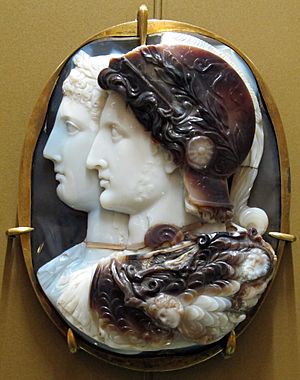Gonzaga Cameo facts for kids

The Gonzaga Cameo is a very old and beautiful piece of art. It's a type of cameo, which is a gem with a raised carving. This one was made by carving into three different layers of a stone called sardonyx. It was likely created around 300 BC, during the Hellenistic period.
This special cameo shows the side profiles of a man and a woman. It was a prized possession of the Gonzaga family for many years. When it was first described in 1542, people thought it showed the Roman emperor Augustus and his wife Livia. Over time, others suggested it might be Alexander the Great and his mother Olympias, or other famous couples from history.
The man on the cameo wears things that remind us of Alexander the Great. He has a helmet decorated with a laurel wreath. He also wears a gorgoneion, which is a symbol often seen on shields. Another symbol on his armor looks like the head of Zeus Ammon, a powerful god. A snake is wrapped around his laurel wreath, which might represent a royal symbol called the uraeus. The man and woman's faces are shown together, perhaps to look like the gods Zeus and Hera. You might notice a brown necklace on the cameo. This was added later to hide a crack where the cameo broke in half long ago.
Contents
Who Owned This Famous Gem?
This amazing cameo has had many famous owners throughout history. It traveled across Europe and was admired by kings, queens, and artists.
From Mantua to Vienna
A young artist named Peter Paul Rubens once worked for the Duke of Mantua. He thought the Gonzaga Cameo was the most beautiful gem ever made. During a conflict called the War of the Mantuan Succession, soldiers took the cameo to Vienna. It was kept safe in the treasury at Prague Castle during the Thirty Years' War.
Looted and Rediscovered
Towards the end of the Thirty Years' War, Swedish soldiers attacked Prague in 1648. They took many treasures, including the Gonzaga Cameo, from the imperial treasury. Years later, the cameo appeared in the art collection of Queen Christina of Sweden. She likely took it with her when she moved to Italy. She then gave it to her friend, Cardinal Decio Azzolini.
From Cardinals to Emperors
After Cardinal Azzolini, the cameo became part of the collection of Livio Odescalchi, a duke and nephew of Pope Innocent XI. In 1794, it was owned by Pope Pius VI and kept in the Apostolic Palace in Vatican City. When French forces invaded, they took the cameo to Paris. It then became part of the collection of Napoleon and his wife, Empress Joséphine.
A Gift to the Tsar
After Napoleon's power ended, Alexander I of Russia visited Joséphine. As a thank you for his help, she gave the Gonzaga Cameo to the Tsar. Since then, this special gem, sometimes called the Malmaison cameo, has been kept in the Hermitage Museum in Saint Petersburg, Russia.
It's interesting to note that there's another old cameo in Vienna that some people also call the "Gonzaga cameo." This has caused some confusion, but the one in the Hermitage Museum is the most famous and well-known.
What Does the Cameo Show?
The cameo shows the side views of a man and a woman. They seem to look a bit alike, suggesting they might be related. This style of showing two profiles together was common on coins from Hellenistic Egypt. For example, coins from Ptolemy II Philadelphus often showed him with his sister and wife, Arsinoe II.
Ptolemy was the first Greek ruler in Egypt to marry his sister. In his court, the idea of "twin deities" or "godly siblings" became popular. Some experts believe the woman's head on the cameo is covered with a special bridal veil, which supports the idea that it shows Ptolemy and Arsinoe.
However, not everyone agrees on who the figures are. A scholar named J. J. Pollitt from Yale University thinks the cameo in Vienna is the one that shows Ptolemy and Arsinoe. He believes the Saint Petersburg cameo was made later because of its very clear and detailed carving. He suggests the figures might be the Roman emperor Tiberius and his mother Livia. He thinks they were shown in a way that would remind people of Ptolemaic cameos, and through that, of Alexander the Great.

